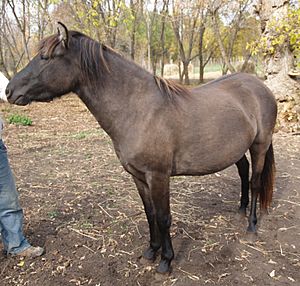Lac La Croix Indian Pony facts for kids

Lac La Croix mare
|
|
| Other names | LLCIP, Lac La Croix Indigenous pony, Lac La Croix pony, Ojibwe pony, bebezhigooganzhii, mishdatim |
|---|---|
| Country of origin | Canada |
| Traits | |
| Height |
|
| Colour | Any solid color except white or cream dilutions |
The Lac La Croix Indian Pony (often called LLCIP) is also known as the Ojibwe pony. In the Ojibwe language, it's called bebezhigooganzhii or mishdatim. This special horse breed was developed by the Ojibwe people in Canada.
These ponies used to live in the wild or semi-wild. But by 1977, there were only four female horses (mares) left! To save the breed, these mares were bred with Spanish Mustang stallions. The breed gets its modern name from the Lac La Croix First Nation in Ontario, Canada. This is where the last wild ponies were found. Today, the Lac La Croix Indian Pony is still a critically endangered breed, meaning it's very rare.
Contents
What Makes Them Special?
The Lac La Croix pony is a small riding horse. It usually stands about 122 to 147 centimeters (or 12 to 14.2 hands) tall. You can find them in many solid colors, like black and bay (a reddish-brown). They also come in dun shades, which are brownish-yellow colors. These dun ponies often have "primitive markings" like a dark stripe down their back.
These ponies are very tough and strong. They have smooth, easy ways of moving (called gaits). People say they are gentle and smart. The Lac La Croix pony is the only horse breed that was developed by Indigenous people in Canada.
Built for Cold Weather
These ponies have special features that help them in cold weather. Their ears are small and have lots of hair. They also have nostril flaps that can tighten up in bad weather. This helps protect them from the cold.
Their bodies are also built for strength. They have low withers (the part of a horse's back between the shoulder blades). They also have a short, straight back and a sloping croup (the top of their hindquarters). Their cannon bones (lower leg bones) are very strong. Plus, they have thick manes and tails.
Their Family Tree
Scientists believe the original Lac La Croix ponies were a mix of Canadian horse and Spanish Colonial horse or Mustang breeds. When only four mares were left, they were bred with Spanish Mustang stallions to save the breed.
Studies show that these ponies also have some British pony ancestors. They are known as an Indigenous horse breed of Canada. However, they are at risk of a "genetic bottleneck." This means their family tree is very small, which can make them less healthy. Because of this, it's very important to protect them.
A Look Back: Their History
The Lac La Croix pony breed grew up in the Great Lakes area, between southern Canada and the northern United States. These ponies were very important to the Ojibwe people. They were used as working animals, especially in winter.
They helped people ride along trap lines and pull heavy loads of ice and wood. They also pulled sleighs through the snow. After winter, some ponies were led across frozen lakes to a special "Pony Island." Here, they could run free and have their foals safely until the next winter. Other ponies moved freely between Ontario and Minnesota.
A Declining Population
Around 1900, there were thousands of these ponies. They lived in many First Nation reserves in the area. But during the 1900s, their numbers started to drop.
One reason was that Indigenous people were not allowed to leave their Reserves without permission. This limited where they could go with their horses. Also, as more people settled, the land where the ponies roamed became smaller. Some horses were even taken away from the Ojibwe people.
When Quetico Provincial Park was created in 1913, many Indigenous people were moved from their homes. This likely included their horses too. Free-roaming horses were especially at risk because no one was watching over them. Later, new machines like snowmobiles replaced horses for many jobs.
The Rescue Mission
The last group of ponies in the United States was in Minnesota. Sadly, they were all lost in the 1940s. The last Canadian community to keep their ponies was the Lac La Croix First Nation. By the 1960s, only six horses were left. One young male (colt) was accidentally shot, leaving no breeding males.
In 1977, the Canadian government planned to remove the last four mares. But the Bois Forte and Lac La Croix people quickly planned a rescue! They loaded the mares into a horse trailer. Fred Isham, an Ojibwe man, drove them to Minnesota. There, the mares were safe on a farm.
Since there were no male ponies left, a registered Spanish Mustang stallion named Smokey was used for breeding. The first male foal, Keokuk, was born in 1980. Another colt, Nimkii, was born in 1985. These two stallions helped start the modern Lac La Croix bloodlines.
Saving the Breed Today
In the 1990s, the Lac La Croix Indian Pony was listed as a rare breed. By 2007, it was called "endangered." Today, it is still considered "at risk." It is on the conservation list of Heritage Livestock Canada.
Now, there are about 150 Lac La Croix ponies. They live in Ontario, Saskatchewan, Alberta, and Minnesota. Scientists believe it's very important to protect these ponies to keep their unique genes alive.
How They Are Used Today
Today, the Lac La Croix Indian Pony is seen as a "spirit animal" by the Ojibwe people. They are used in programs that help teach about Indigenous heritage.
These ponies also help people in other ways. They are used in equine-assisted therapy, where horses help people with their emotional and physical health. They are also part of tourism. Most importantly, they help Indigenous youth connect with their culture and history.


